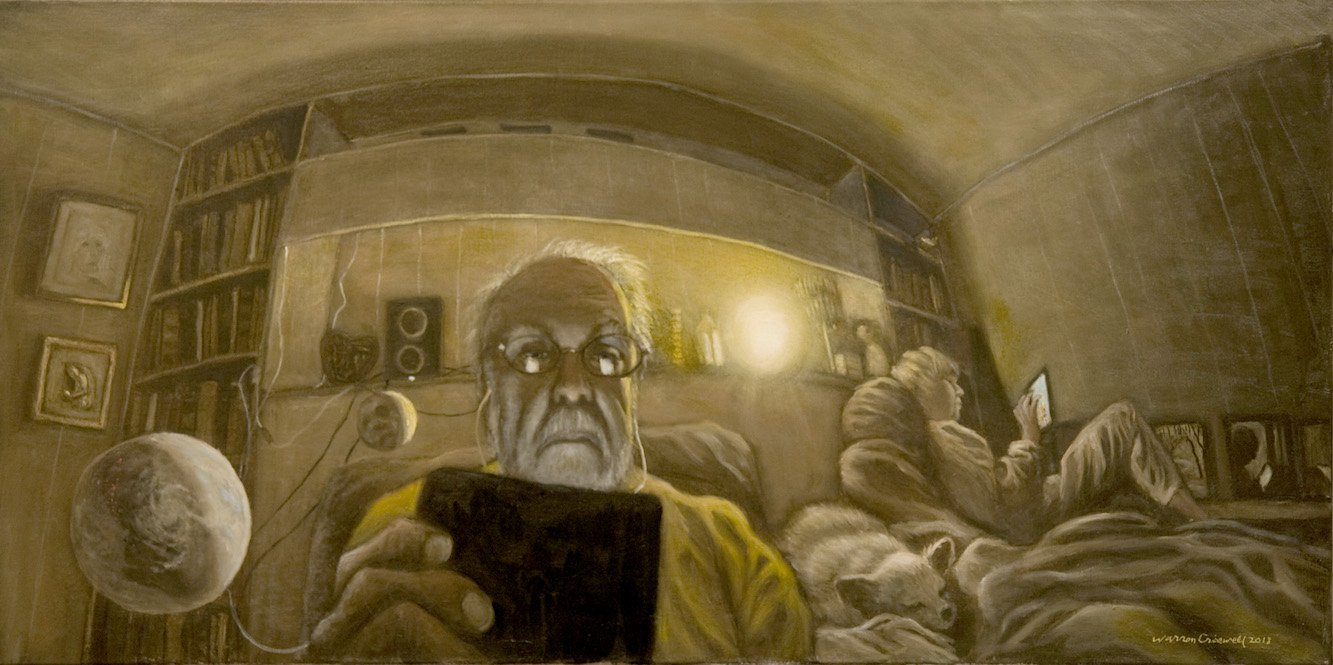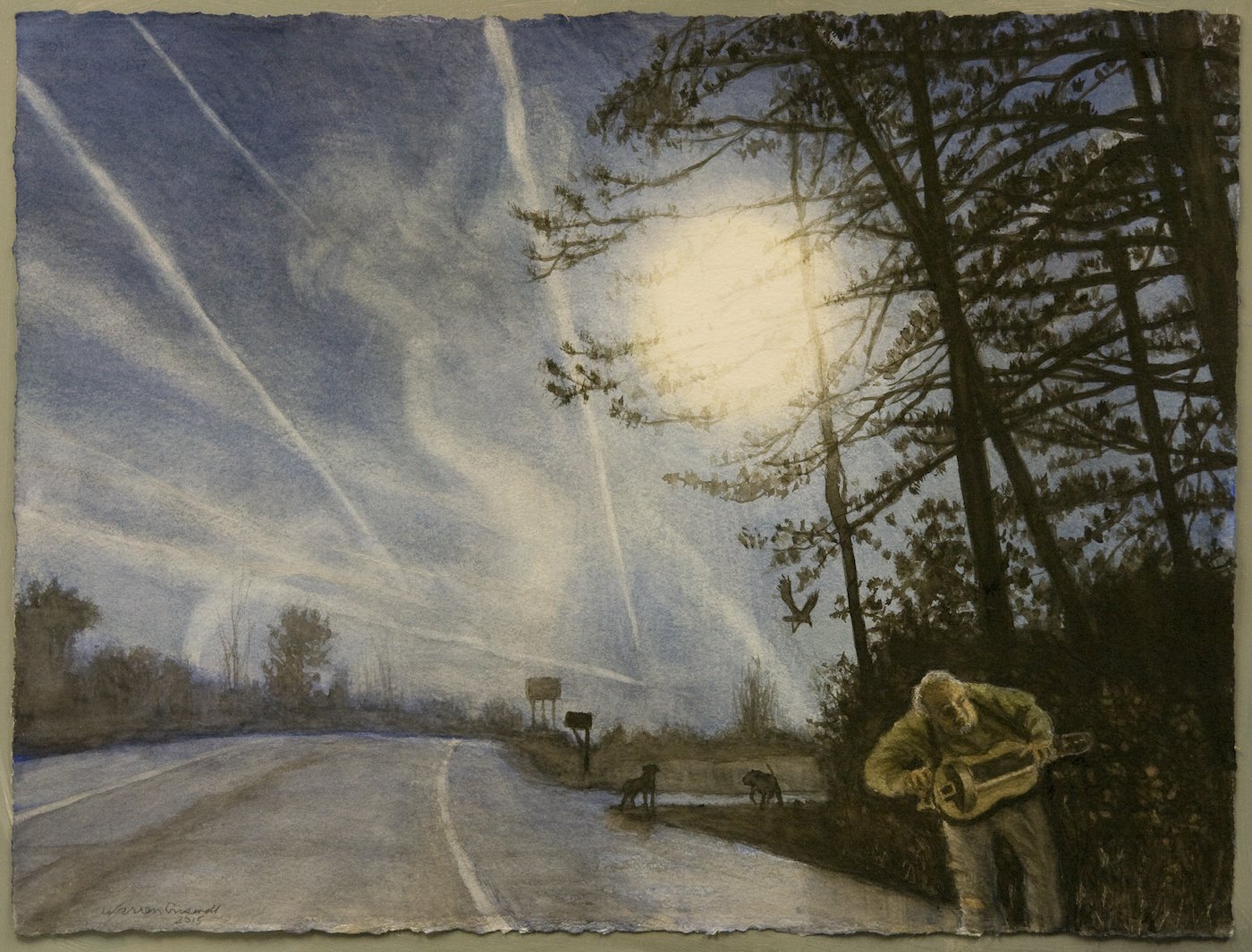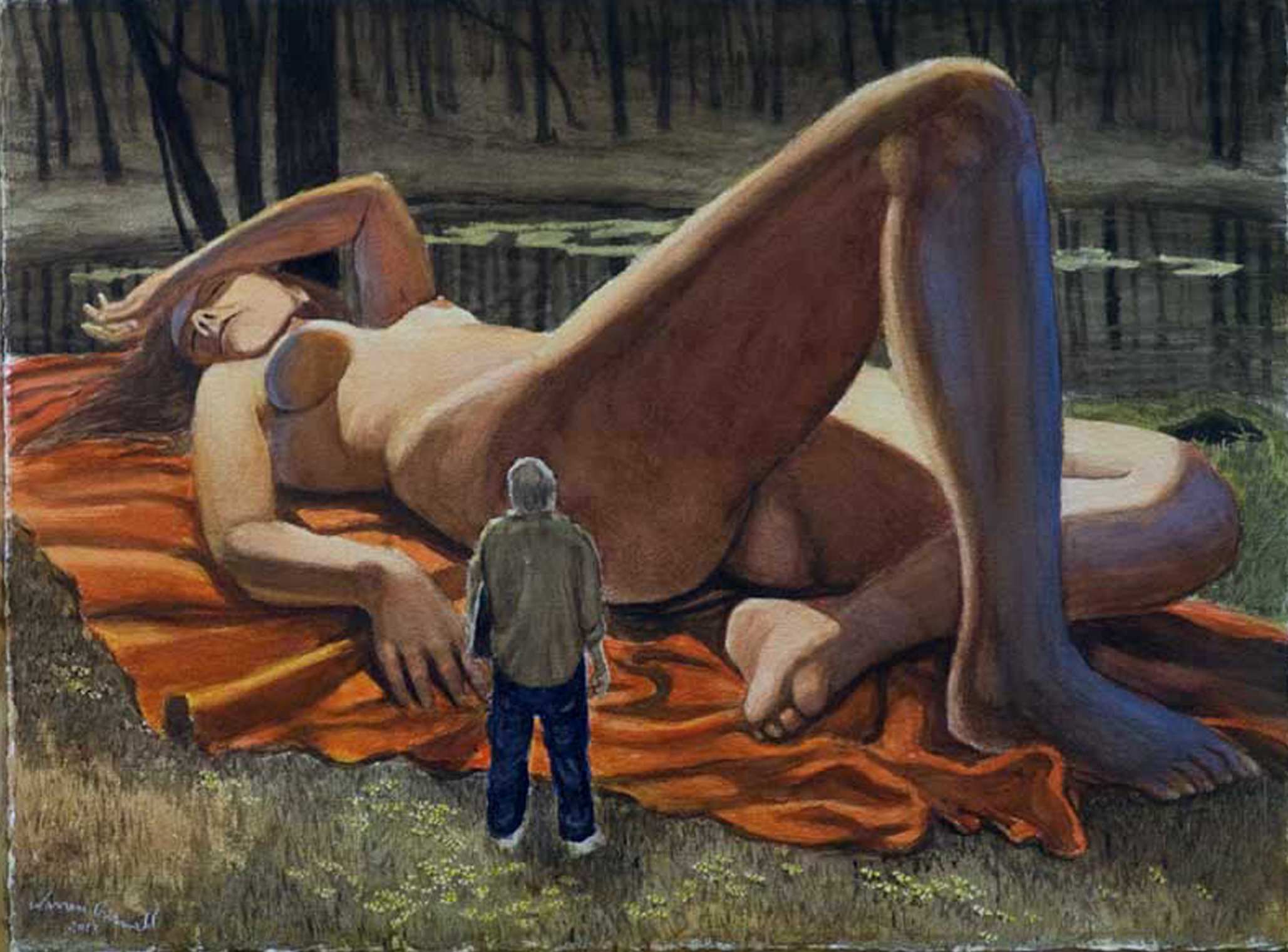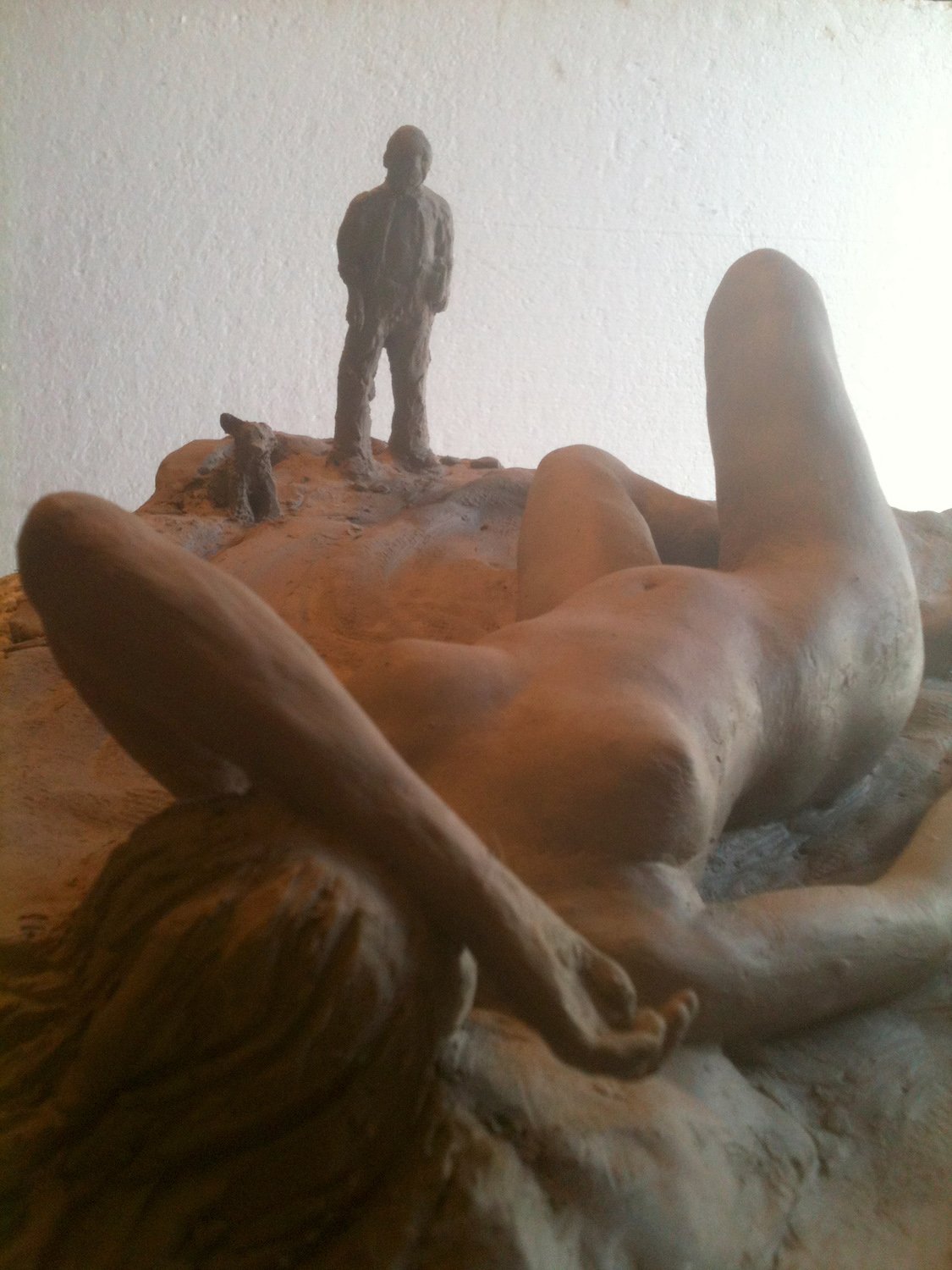Interview with artist Warren Criswell
Warren Criswell ‘landed’ in Arkansas in 1978 after leaving Florida with his family. For four decades, Warren has been making his mark on the Arkansas Art Scene. His body of work is extensive but instantly recognizable. In 1996 he was awarded a fellowship grant for painting and works on paper by the Mid-America Arts Alliance and the National Endowment for the Arts, and in 2003 an Individual Artist Fellowship Grant for painting and drawing by the Arkansas Arts Council. He was also awarded the Arkansas Governor's Individual Artist Award for 2021. More of Warren’s work can be found at M2 Gallery in Little Rock and at his website warrencriswell.com.



AAS: Warren, in my interview with your daughter, Kae Barron, in December, she mentioned the family’s move to Arkansas from Florida. It sounded like quite an adventure. What is your version of the story?
WC: Well, it's a long story, but I'll try to be brief. I had read Limits to Growth by The Club of Rome, which predicted an ecological collapse of the global industrial civilization around 2050, due to overpopulation, overuse of nonrenewable resources and pollution. And Florida was being ruined by tourists and the sugar industry. I wanted to find a piece of cheap land somewhere and set up a self-sustained off-the-grid homestead where we would grow our own food, use solar energy, write about it and save the world. Yeah, right. Of course, none of that happened, but in 1972 we bought a bus, sold our home, and hit the road. I had shown paintings at Alex Kirkland's Gallery 14 in Palm Beach and worked as a land surveyor, but at this time I was living off writing pulp novels under a pseudonym for Greenleaf Publishing in California, so I didn't have to live in one place. We traveled around for a few months until, while camping in Ohio, my publisher stopped buying, and it was getting cold, so we headed south. I was working on an apocalyptic novel, in which sea level rise flooded the Mississippi delta, putting Little Rock on the coast, so I thought I should go there for some research. We ended up at the KOA in North Little Rock, from where I landed a job surveying for the Corps of Engineers in Louisiana, staking out dikes along the river. I eventually quit the Corps and got a job in a print shop in Natchitoches, where I learned photolithography. During the two years in Louisiana, before we moved back to Arkansas, I taught myself watercolor, and when we finally got our piece of land, a few acres near Benton with a doublewide on it, I started showing my watercolors at Norman and Helen Scott's gallery in Little Rock, later to become Cantrell Gallery. I had a job at a print shop, but Norman and Helen sold enough of my works that, with the income from Janet's businesses, I was eventually able to quit my job and become a full-time artist. In 1982 a tornado destroyed the mobile home and overturned the bus, after which we built our current house, office and studio.
AAS: So, you consider yourself a mostly self-taught artist. But you did have some instruction and ‘imprinting’ from your mother growing up, didn’t you?
WC: Yes, my mother was a Sunday painter, so I grew up smelling linseed oil and turpentine, but she didn't teach me to paint. They told me I could draw before I could walk. I drew all during my childhood and took classes at Norton School of Art in West Palm Beach in grade school. That's about all my formal training until I attended some sculpture classes taught by Michael Warrick at UALR in 2007 to learn bronze casting, and some printmaking classes from Aj Smith at Arkansas Arts Center. My work went through many changes, from the expressionistic paintings I did in Florida, to the photorealistic watercolors I did in my early years in Arkansas, to the dark sometimes surreal oils I started doing in 1983. I fell under the spell of the Old Masters, especially Rembrandt, Caravaggio, and Titian, whose techniques I had to teach myself through research and experimentation, even making my own paint like they did, although I stored it in metal tubes, not pig bladders.
AAS: You have done many self-portraits. They are poignant, often humorous, always ‘revealing’ (Ha). The Question is really extraordinary and has in it everything I associate with a Warren Criswell painting. Are your self-portraits in some way therapeutic?
The Question, 36” x 48”, oil on linen
WC: The Question was apparently a conflation of several sources. I know I had been reading Sartre's "The Question" in Being and Nothingness, which brought to mind that chapter in Dostoevsky's The Brothers Karamazov, in which one of the brothers imagines a returned Christ being captured and interrogated by The Grand Inquisitor. And I had surely been looking at El Greco's portrait of Cardinal Inquisitor Niño de Guevara. But I interpreted all this in terms of the doppelgänger: a kind of Jekyll-and-Hyde, superego/id pair played by me as both the Grand Inquisitor and his prisoner. Yeah, it does kind of look like an attempt at therapy, doesn't it? I used to think it wasn't me I was painting, it was just that I couldn't afford real models, but eventually I realized it was me after all. The Question led to a years-long series.
Man PIssing from the exhibition Face to Face – Artist’s Self-Portraits from the Collection of Jackye and Curtis Finch, Jr. at the Arkansas Arts Center in 2013, curated by Brad Cushman.
AAS: Another wonderful self-portrait is a drawing that is part of the Jackye and Curtis Finch, Jr. collection and was in their traveling exhibition Face to Face. What is the story behind that drawing?
WC: I think that was a drawing they bought at a show at Historic Arkansas Museum. It had something to do with guilt and getting caught, and is related to this painting: The Trespasser.
AAS: I was really not aware how many different types of media you have worked with – oil, clay, metal, linocut, watercolor, animation and more, I’m sure. And you have explored some of your subjects and compositions in more than one media. I am thinking of Go Ask Alice, here. I get the sense that you enjoy challenging yourself.


WC: Yes, when I get an image, I milk it for all it's worth, often doing a drawing, a watercolor, an oil, a print, sometimes a sculpture, even an animation. Concerning Go Ask Alice, sometimes an actual work of art can emerge from what you thought was just an exercise. This time I was sitting in on a life drawing class set up by Stephen Cefalo at UALR. I had exaggerated the perspective in my drawing, and Stephen said, "It looks like you've just come out of the woods and discovered this huge woman!" Immediately this image came into my head – with Grace Slick singing "White Rabbit" as the soundtrack. I also made an oil, a linocut and a sculpture from this image. [A rotating Alice can be seen here.]
AAS: I was blown away by Sunday at Yogi’s. I believe it is one you did soon after arriving in Arkansas? How are the details in that painting even possible with watercolor? Did it take long to complete?
WC: The painting was inspired by a snapshot my wife took of her parents, Anna and Ray Seal, on a visit from Florida to Yogi Bear campground in Benton, where we were staying back in 1977. I don't know how long it took, probably about a month. But the challenge and fun turned out to be rendering in watercolor both sides of the Arkansas Gazette funny papers as the sun shone through them. So, this is a kind of memorial for that paper, as well as for Anna and Ray, which is why their daughter, my wife Janet, won't sell it. It is now hanging in our living room.
Sunday at Yogi’s, 24” x 37”, watercolor
Fly Me to the Moon, 30” x 23”, watercolor and collage
AAS: Another watercolor I love is Fly Me To The Moon. What is the story behind that painting?
WC: Just Janet and me walking in our outback in the foggy fall, a love song to my amazing wife. The falling leaves are all cut from drawing paper, painted with watercolor and crumpled to give them natural shapes. I kept out a few of these leaves, and wherever it was hung I instructed the curator to drop a few on the gallery floor below the painting. Of course, they never did.
AAS: A number of your works include a solitary bird, often a crow. What is your meaning behind that? I am thinking especially here of your linocut, The Culvert.
WC: I heard from my friend, the printmaker Evan Lindquist, that his son Carl had fallen ill in India, where he teaches at a university in Bangalore, and was now in a hospital bed – and writing poetry! So I go to his Facebook page and the first thing I see is this poem: A Winding Arc Toward Noon.
The Culvert, 9” x 11”, 2-color linocut
I had been in a slump, inspired by nothing, but this poem knocked me out. I had been there, down by that river, and whenever I got desperate enough I would paint an image of that despair, and that would kick me out of it. I felt like this was what Carl was trying to do, at the same time seeing the joke on himself. Buddha said to be born was suffering, living was suffering, dying was suffering. Shoot the son of a bitch. But he just laughs in your face. Ha. I was strangely inspired by that poem, but then I realized that I had already painted it, The Culvert, in 2007! This is the final frame in my animation, The Crow. I had the river, the unexpected sunrise, the red wound of dawn, the gun, the bullet and the arc toward noon. True, instead of the Buddha I had the crow, but the crow is Death, and you can no more kill Death than you can kill the Buddha, so to me the painting and the poem had the same meaning. I hadn't made a print of that image, so I decided to try it then. The linocut of The Culvert is the result. A linocut is a relief print like a woodcut, with the image cut from one or more pieces of smooth linoleum instead of wood blocks. But I use a radically unconventional method invented by Picasso and his printer, Arnera, which I have adapted to my own needs. They are true relief prints, though they may not look like it, and since I'm the only one in the world doing this, as far as I know, I'm calling it The Criswell Linocut. All of the technical details can be found at my website [here].
Death Waking Time, 9” x 11”, 2-color linocut
We're all immortals for most of our lives, but at some point, we realize we're going to die like everybody else. And at that point time becomes precious. But in another of my linocuts, Death Waking Time, Death is not the Grim Reaper but a beautiful woman! She's not closing down life but opening it up for the dude on the bed. Fly away, crow. Not dinner time yet.
AAS: Tell me about Burnout.
WC: I was writing a letter to a poet friend of mine, trying to tell her how burnt out I was feeling: In the pit, abandoned by the muse. Surely, I had painted everything worth painting, discovered everything worth discovering. And with the world going to hell, the planet cooking, soon to be uninhabitable, there wouldn't be any posterity to discover my work, which would probably be burnt up, washed away in a flood, or blown up by a nuclear bomb anyway. So, to illustrate this feeling I did a drawing for her. Well, in her reply she said she loved the "burned out" drawing, so I thought maybe I would try to paint it. Sometimes in the past, as I explained above, when feeling desperate I would paint an image of my despair and that would resurrect my creativity. And that's eventually what happened this time. But then while painting this the October 2017 California fires started, wiping out whole neighborhoods and killing dozens, so that the humorous aspect of my painting now seemed disrespectful of those for whom this imaginary nightmare had become a reality. Bad timing.
Burnout, 30” x 40”, oil on canvas
And then in November of this year pianist and composer Margin Alexander contacted me to ask if he could use an image of my painting, Burnout, in a concert he was planning in New York. He said he was moved and inspired by this painting and asked if I would like to be a part of his upcoming music exhibition, to be live-streamed in HD. Of course I sent him the image. The event was called "December, A Blank Canvas for My Piano," and was live-streamed on Dec 21, 2021. This guy plays at Carnegie Hall and all over the world and composes very moving music. I am proud to have provided a small part of his inspiration. But it's kind of ironic that this painting should be getting attention now, when I am truly and possibly permanently burnt-out, thanks to my stroke, which disabled the use of my dominant left hand. [View the concert here. Warren’s section is at 6 minutes in.]
AAS: Another characteristic I associate with a Criswell painting is a strong and often ominous light source. Still Life with Keys is one of your still life paintings that has this mysterious almost foreboding light – but it is of a bathroom vanity! There is the twist!
Still Life with Keys, 14” x 12”, oil on hardwood
WC: Yes, It's always the light and shadow that gives me an image. I thought my still lifes would be a break from my narrative images. I had been reading about phenomenology and I wanted to paint "the things themselves,” no stories. But when I began showing them, viewers said they were my most intimate self-portraits. And I realized that we see stories in all images. There are no "things themselves.”
AAS: What has been the most fun for you, the development of a composition or the actual execution of the final painting? I am thinking here of your epic work, Götterdämmerung.
Gotterdammerung (The End), 36” x 48”, oil on canvas
WC: I don't know, it's all fun. Gotterdammerung (The End) is my version of Wagner's "Twilight of the Gods,” a sort of rounding up of most of my past images and themes, lemmings on their way to the final jump. Only the Rhine maidens down there in the river (once I-30) will be left, and how long can they last? [To see the paintings and drawings referred to in this painting, run your cursor over this image map.]
AAS: You have been very open about your struggle to learn to paint again. Would you talk about your two recent works, Epilogue (The Red Giant) and Waiting, and what the process has been like?
Epilogue (The Red Giant), 24” x 30”, oil on canvas
WC: I had just started Epilogue when I had my stroke in August of 2018, and finished it, right-handed a year later. The scene is a few billion years in the future, long after we humans have wiped ourselves out or left the planet we ruined, when the sun will have used up its hydrogen fuel and become a helium-burning red giant, swallowing Mercury, Venus and Earth. Having Archy watch it happening was an attempt at humor, but it's well known that cockroaches are one of the few species (not including ours) predicted to survive climate change, having survived other mass extinction events in Earth's past. The swallowed Moon has become a pain emoji, about a number 12.
Waiting, 18” x 24”, oil on canvas
Waiting was my first right-handed attempt at a new painting since my stroke. I am waiting for the sunset, my left hand, my muse and balance to come back. The crow of course, faithful to the grave, is waiting for me to die.
AAS: Warren, you have received so many awards over the years including the Arkansas Governor's Individual Artist Award for 2021. When you think back over your career, what have been some of your most meaningful and satisfying achievements?
WC: Of course, it's always gratifying to win awards. Good for the ego and something to put on the resume, sometimes in the bank, but I guess the most satisfying achievement is the successful completion of a work. And while my Arkansas friends, especially artists Sammy Peters and David Bailin, but also Leslie Peacock and Hamid Ebrahimifar, have greatly helped and encouraged me through the years, I owe most to my loving and supporting wife, Janet, without whom I would be under a bridge somewhere, wrapped in newspapers.


